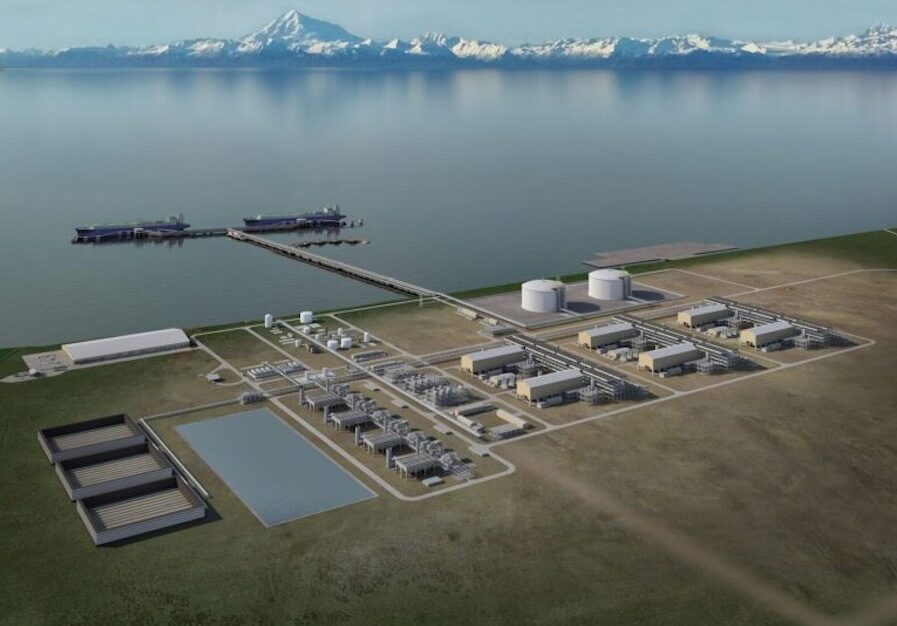The future of the proposed Alaska LNG project could be decided by the end of the year, according to the private energy firm that last month acquired a majority stake in developing the estimated $44-billion export terminal and feeder pipeline from a state-owned entity
New York City-based energy infrastructure developer and operator Glenfarne Group LLC, which agreed to buy a 75% stake in the project from Alaska Gasline Development Corp., says it will soon begin front-end engineering and design on Alaska LNG, including an 807-mile, 42-in diameter pipeline that will carry up to 3.3 billion cu ft of gas per day to a new liquefaction facility in Nikiski, southwest of Anchorage. That facility will have capacity to produce 20 million tonnes of LNG per year for transport via tankers to overseas markets, particularly in Asia.
Alaska LNG also includes construction of a North Slope-based carbon capture plant that Glenfarne says will remove and store 7 million tons of carbon dioxide annually.
Glenfarne founder and CEO Brendan Duval has stated publicly that the project’s front-end process, estimated to cost up to $150 million, will get underway soon and last about six months, leading to a final investment decision by the end of 2025. Should Glenfarne elect to pursue further development at that time, LNG deliveries from the project could begin by 2031, he added.
Japan, Korea, Taiwan and Thailand have been identified as prospective customers for Alaska LNG’s output, although no official purchase agreements have been announced.
Duval said funding for construction and operation is expected to come from “a consortium” of private investors. The project is eligible for an 80% federal loan guarantee, authorized by the Infrastructure Investment and Jobs Act.
Should Glenfarne decline to move forward with Alaska LNG, the company will be able to collect up to $50 million from a “backstop” fund established by the Alaska development entity last December.
Glenfarne currently has two other major U.S. LNG projects underway. LNG Texas, a 4-million-tpy export facility in Brownsville, Texas, is set to begin operations in 2028 with Kiewit serving as engineering, procurement, and construction contractor. A final investment decision on that project is expected later this year. The 115-acre Magnolia LNG export site near Lake Charles, La., acquired by Glenfarne in 2020, holds permits to produce nearly 9 million tpy.
Launched in 2010, the effort to develop Alaska LNG has languished in part because of its huge price tag, which led to withdrawal of original investors ExxonMobil, BP and ConocoPhillips. The state developer continued to pursue the project on its own, eventually securing federal approval in 2020.
The project’s prospects improved in 2022 with release of a revised cost projection with a more favorable economic outlook including a more than $6-billion reduction in capital costs coupled with a projected rise in global LNG demand, particularly in Asia, and introduction of a new financing plan that includes a nonrecourse 70% debt-funded third-party tolling structure.
The report noted that constructing the pipeline also would provide an immediate solution to a looming natural gas supply shortage facing utilities that supply power to Alaska’s south-central urban areas. State and utility officials have warned that local sources are on the verge of depletion, increasing the threat of service disruptions occurring as soon as next winter.
President Donald Trump’s Inauguration Day executive order prioritized development of Alaska’s natural gas reserves, but the Alaska LNG project also been supported by the Biden administration, with its U.S. Energy Dept. renewing the existing approval last year following consideration of environmental studies performed after the 2020 final environmental statement.
That document found that construction and operation of Alaska LNG would result in “temporary to permanent” environmental impacts, most of which would not be significant or would be reduced to less than significant levels via “recommended avoidance, minimization, and mitigation measures.” The project also has survived several recent court challenges from climate activists.
